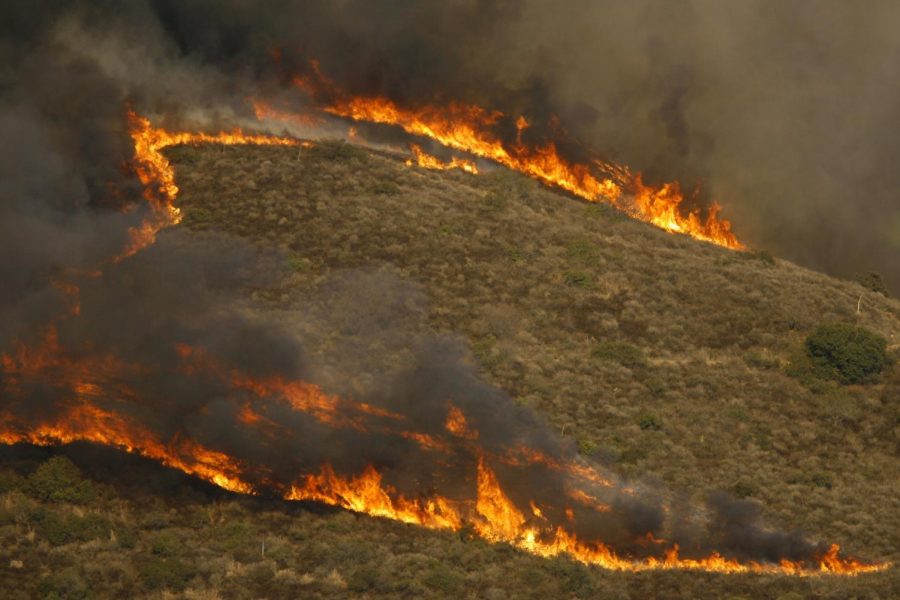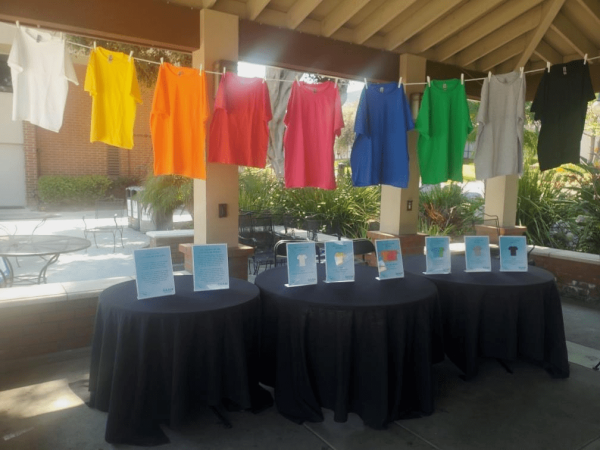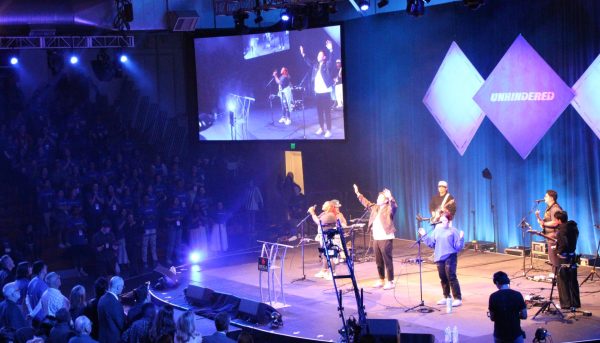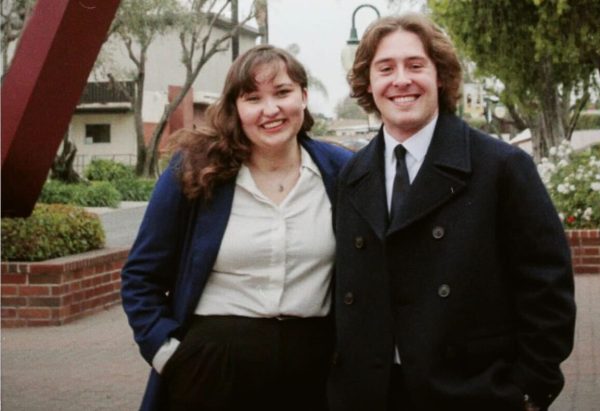Fire evacuations largest in SoCal history
More than 500,000 flee as wildfires continue to torch SoCal homes
Lines of fire spread along the Santiago Canyon hills Tuesday, Oct. 23, 2007, in Silverado, Calif. Mandatory evacuations are in place for for the canyon areas northeast of Santiago Canyon Road between
October 10, 2007
SAN DIEGO, Calif. – Deadly, wind-whipped wildfires have triggered the largest evacuation in state history, prompting more than 500,000 people to flee ahead of flames that destroyed nearly 1,300 homes and continued Tuesday to threaten tens of thousands more.
The number of people joining the mandatory exodus _ and the number of homes destroyed _ was expected to grow as new fires started and others continued to burn a path toward the sea _ through populated communities.
”This is the largest mass evacuation of a natural disaster in California history,” said Daniel Berlant, spokesman for the state’s Department of Forestry and Fire Protection.
In San Diego County, authorities placed evacuation calls to more than 346,000 homes, said Luis Monteagudo, a spokesman for the county’s emergency effort. The county estimates, based on census tracts, that approximately 560,000 people were ordered to leave, said Ron Roberts, chairman of the San Diego Board of Supervisors.
To the northeast, fires in the San Bernardino mountains forced the evacuation of entire communities surrounding the resort area of Lake Arrowhead.
Thousands of people, including hospital patients, were forced to flee advancing flames that leaped through the mountains, burning one home after another, destroying at least 300 and threatening as many as 10,000 more, said U.S. Forest Service spokeswoman Gina Sampson.
By late Tuesday, fire officials who were trying to get an accurate count of homes destroyed in Southern California put the number at 1,286.
In neighboring Orange County, a fire chief lashed out at state officials, saying air support, such as tankers, might have helped control fires early on, before they burned homes, if it had been available. It wasn’t because so many fires struck California almost simultaneously beginning last weekend.
”There is not enough resources to go around … because of the number of fires that are going on in our state right now,” said Orange County Fire Authority Chief Chip Prather.
He said a dozen firefighters battling blazes in the Irvine and Lake Forest areas had to deploy emergency shelters, a last resort when they are surrounded by flames, or take cover in buildings.
”They should not have had to do that,” he said. ”If we’d had the resources earlier to take care of those lines with hand crews, we wouldn’t have been in that situation.”
Prather’s comments came minutes before Gov. Arnold Schwarzenegger, touring fire damage in Lake Arrowhead, promised more help, including more people and equipment.
When asked about the fire chief’s critical remarks, the governor said: ”I’m not aware of that.”
Berlant defended his agency’s actions, saying it had gone on high alert late last week and shifted resources to the San Diego area in advance of the forecasted Santa Ana winds.
On Tuesday, the fire agency took the additional step of suspending the closing of fire season in Northern California, a maneuver allowing it to send virtually every state fire engine, some from as far as 800 miles away, to battle the Southern Californiafires.
Caravans of fire engines could be seen rolling down Interstate 5 _ more than 500 miles and a day’s drive from the closest blaze.
Meanwhile, in San Diego County, site of the only death so far, another 530 homes were reported damaged.
Besides the one person killed by the flames, the San Diego medical examiner’s officer listed four deaths as connected to the wildfires. Three were people in their 90s who died from natural causes; the fourth was a woman who died after falling at a restaurant.
All are considered fire-connected deaths because they occurred during or after evacuations.
The fire victim was identified as Thomas Varshock of Tecate, a town on the U.S. side of the border southeast of San Diego, the San Diego County Medical Examiner’s Office said. Authorities had told him to evacuate, but he didn’t leave and authorities left to take care of other evacuations, the Medical Examiner’s Office said.
There were 45 injuries reported throughout Southern California, including at least 21 firefighters. The University of California, San Diego Medical Center Regional Burn Center was treating 16 patients from the San Diego County fires, including three firefighters and four others in critical condition.
With some 410,000 acres, or 642 square miles, ablaze, President Bush declared a federal emergency for seven Southern California counties, a move that will speed disaster-relief efforts. He also scheduled a visit to the region on Thursday.
The Department of Defense also agreed to send six Air Force and Air National Guard water- or retardant-dropping planes.
Fire crews and fleeing residents described desperate conditions that were sure to get worse. Temperatures across Southern California were about 10 degrees above average and approached 100 degrees Tuesday in Orange and San Diego counties where sustained Santa Ana winds gusted in some areas to 65 mph.
The fires were exploding and shooting embers before them in all directions, preventing crews from forming traditional fire lines and greatly limiting aerial bombardment.
In Orange County, flames tore through Modjeska Canyon, forcing firefighters to take cover and destroying homes.
”Our house is still there right now but there are only six houses on our street that are still standing,” said Vallary Townsell, 25, who lives in the canyon and works as a reporter with local cable TV Channel 3.
Ben Viloria also lived in the area and returned Tuesday night to find his home still intact. To allay overnight flare-up worries, he linked two garden hoses and sprayed water on embers that had settled inside the hollow base of olive trees that line the canyon.
”It looks like the moon,” Viloria said of the destruction. ”Incredible, really.”
Thousands of residents throughout Southern California sought shelter at fairgrounds, schools and community centers.
The largest gathering was at Qualcomm Stadium in San Diego, where evacuees anxiously watched the stadium’s television sets, hoping for a glimpse of their neighborhood on the local news.
The clubhouse at the famous Del Mar racetrack was converted into a shelter. Hundreds of people starred at television sets blaring reports from the fire lines and damaged neighborhoods. Many dozed on cots, their countless pets penned in with temporary fencing.
”We’re going crazy trying to get back into our apartment just to see what kind of damage we’ve got,” said Tim Harrington, who arrived at the racetrack with his wife, son and their two pet rats. ”Then we’ll pick up the pieces from there.”
Just outside the clubhouse, barns that usually house thoroughbred race horses sheltered a variety of large animals.
”I’d say spirits are pretty good. The biggest question is, ‘When can we go back to our homes?’ We have to tell them we have no idea. All we can tell them to do is tell them to watch those TVs,” volunteer coordinator Beverly Ferree said.
By Tuesday evening, some 50,000 people in San Diego were being allowed to return home, Roberts said. Many returned to two evacuated neighborhoods in San Diego _ Del Mar Heights, near the ocean, and Scripps Ranch _ as well as an evacuated portion of the city of Poway. No homes were lost in these particular neighborhoods.
Public schools will be closed through the remainder of the week, as will campuses at the University of California, San Diego and San Diego State University. National Guard troops were manning highway checkpoints in San Diego County.
At Marine Corps Air Station Miramar, about 40 aircraft that included F-18 fighter jets, C-130 cargo planes and Marine helicopters were evacuated to other bases in California and Arizona. At nearby Camp Pendleton, two fires were burning _ one near the air station and the other in a training area, a base spokesman said. Families in four military housing areas on the base were told to be ready to evacuate.
The scope of the infernos was immense and was reminiscent of the blazes that tore through Southern California four years ago this month, killing 22 and destroying 3,640 homes.
As the fires spread, most out-of-control, smaller blazes were merging into larger, more fearsome blazes.
The winds _ which sweep through Southern California’s canyons in fall and winter _ are stronger than normal, turning already parched scrubland into tinder.
Schwarzenegger, Homeland Security Secretary Michael Chertoff, Federal Emergency Management Agency Administrator R. David Paulison and other officials toured burn areas in San Diego and the evacuation center at Qualcomm Stadium before holding a brief news conference.
”If the weather cooperates, maybe we can turn the tide (Wednesday),” Chertoff said, adding ”hopefully the wind will die down,” so firefighting aircraft grounded by strong gusts could return to the skies.
State insurance commissioner Steve Poizner said he was taking steps to combat the fallout of the fires, including sending his department’s numerous services experts and fraud teams to the region and working with insurance companies to accelerate payments.
Agriculture Undersecretary Mark Rey, who oversees the Forest Service, predicted Tuesday that the fires could cost federal, state and local governments more than $100 million.
Full containment of the most fierce fires in San Diego, officials estimated, could come as early as Nov. 1.







